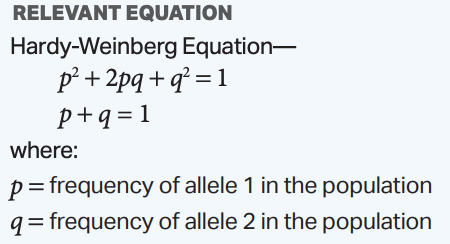7.5 Hardy-Weinberg Equilibrium
1/3
Earn XP
Description and Tags
Evolution is characterized by a change in the genetic makeup of a population over time and is supported by multiple lines of evidence. Describe the conditions under which allele and genotype frequencies will change in populations. Hardy-Weinberg is a model for describing and predicting allele frequencies in a nonevolving population. Conditions for a population or an allele to be in Hardy-Weinberg equilibrium are-- (1) a large population size, (2) absence of migration, (3) no net mutations, (4) random mating, and (5) absence of selection. These conditions are seldom met, but they provide a valuable null hypothesis. Allele frequencies in a population can be calculated from genotype frequencies. Explain the impacts on the population if any of the conditions of Hardy-Weinberg are not met. Changes in allele frequencies provide evidence for the occurrence of evolution in a population. Small populations are more susceptible to random environmental impact than large populations.
Name | Mastery | Learn | Test | Matching | Spaced |
|---|
No study sessions yet.
4 Terms
Hardy-Weinberg
model for predicting allele frequencies in non evolving population
Hardy-Weinberg equilibrium - requires large population size, random mating, no gene flow, no mutations, no natural selection

small populations
more susceptible to environmental impact
non random mating
selection based on preference
migration
brings/removes alleles